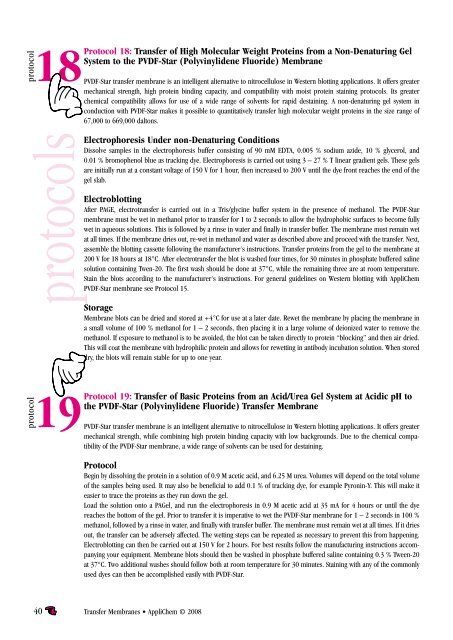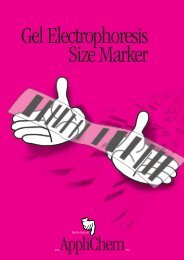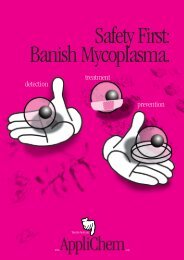Transfer Membranes
Transfer Membranes
Transfer Membranes
Create successful ePaper yourself
Turn your PDF publications into a flip-book with our unique Google optimized e-Paper software.
protocol<br />
18PVDF-Star transfer membrane is an intelligent alternative to nitrocellulose in Western blotting applications. It offers greater<br />
Protocol 18: <strong>Transfer</strong> of High Molecular Weight Proteins from a Non-Denaturing Gel<br />
System to the PVDF-Star (Polyvinylidene Fluoride) Membrane<br />
mechanical strength, high protein binding capacity, and compatibility with moist protein staining protocols. Its greater<br />
chemical compatibility allows for use of a wide range of solvents for rapid destaining. A non-denaturing gel system in<br />
conduction with PVDF-Star makes it possible to quantitatively transfer high molecular weight proteins in the size range of<br />
67,000 to 669,000 daltons.<br />
protocols<br />
Electrophoresis Under non-Denaturing Conditions<br />
Dissolve samples in the electrophoresis buffer consisting of 90 mM EDTA, 0.005 % sodium azide, 10 % glycerol, and<br />
0.01 % bromophenol blue as tracking dye. Electrophoresis is carried out using 3 – 27 % T linear gradient gels. These gels<br />
are initially run at a constant voltage of 150 V for 1 hour, then increased to 200 V until the dye front reaches the end of the<br />
gel slab.<br />
Electroblotting<br />
After PAGE, electrotransfer is carried out in a Tris/glycine buffer system in the presence of methanol. The PVDF-Star<br />
membrane must be wet in methanol prior to transfer for 1 to 2 seconds to allow the hydrophobic surfaces to become fully<br />
wet in aqueous solutions. This is followed by a rinse in water and finally in transfer buffer. The membrane must remain wet<br />
at all times. If the membrane dries out, re-wet in methanol and water as described above and proceed with the transfer. Next,<br />
assemble the blotting cassette following the manufacturer's instructions. <strong>Transfer</strong> proteins from the gel to the membrane at<br />
200 V for 18 hours at 18°C. After electrotransfer the blot is washed four times, for 30 minutes in phosphate buffered saline<br />
solution containing Twen-20. The first wash should be done at 37°C, while the remaining three are at room temperature.<br />
Stain the blots according to the manufacturer's instructions. For general guidelines on Western blotting with AppliChem<br />
PVDF-Star membrane see Protocol 15.<br />
Storage<br />
Membrane blots can be dried and stored at +4°C for use at a later date. Rewet the membrane by placing the membrane in<br />
a small volume of 100 % methanol for 1 – 2 seconds, then placing it in a large volume of deionized water to remove the<br />
methanol. If exposure to methanol is to be avoided, the blot can be taken directly to protein “blocking” and then air dried.<br />
This will coat the membrane with hydrophilic protein and allows for rewetting in antibody incubation solution. When stored<br />
dry, the blots will remain stable for up to one year.<br />
protocol<br />
19PVDF-Star transfer membrane is an intelligent alternative to nitrocellulose in Western blotting applications. It offers greater<br />
Protocol 19: <strong>Transfer</strong> of Basic Proteins from an Acid/Urea Gel System at Acidic pH to<br />
the PVDF-Star (Polyvinylidene Fluoride) <strong>Transfer</strong> Membrane<br />
mechanical strength, while combining high protein binding capacity with low backgrounds. Due to the chemical compatibility<br />
of the PVDF-Star membrane, a wide range of solvents can be used for destaining.<br />
Protocol<br />
Begin by dissolving the protein in a solution of 0.9 M acetic acid, and 6.25 M urea. Volumes will depend on the total volume<br />
of the samples being used. It may also be beneficial to add 0.1 % of tracking dye, for example Pyronin-Y. This will make it<br />
easier to trace the proteins as they run down the gel.<br />
Load the solution onto a PAGel, and run the electrophoresis in 0.9 M acetic acid at 35 mA for 4 hours or until the dye<br />
reaches the bottom of the gel. Prior to transfer it is imperative to wet the PVDF-Star membrane for 1 – 2 seconds in 100 %<br />
methanol, followed by a rinse in water, and finally with transfer buffer. The membrane must remain wet at all times. If it dries<br />
out, the transfer can be adversely affected. The wetting steps can be repeated as necessary to prevent this from happening.<br />
Electroblotting can then be carried out at 150 V for 2 hours. For best results follow the manufacturing instructions accompanying<br />
your equipment. Membrane blots should then be washed in phosphate buffered saline containing 0.3 % Tween-20<br />
at 37°C. Two additional washes should follow both at room temperature for 30 minutes. Staining with any of the commonly<br />
used dyes can then be accomplished easily with PVDF-Star.<br />
40 <strong>Transfer</strong> <strong>Membranes</strong> • AppliChem © 2008





